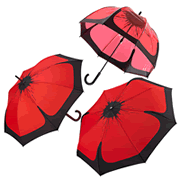A Guide to British Campaign Medals of WW1
There were five campaign medals available for individuals who saw service in the First World War. An individual, male or female, could be issued with a maximum of three of these medals, although there are a small number of exceptions to the rule.
Service medals were issued automatically to other ranks, but officers or their next of kin had to apply for them. Medals were impressed with the name of the recipient and usually included some or all of the following: service number, rank, first name or initial, surname and military unit (Regiment or Corps). This was either on the rim of the medal or in the case of a star, on the reverse.
In addition to the five campaign medals a badge was available to officers and men who had been honourably discharged or had retired as a result of sickness or wounds from war service.
- British Campaign Medal Sets
- The 1914 Star
- The 1914-15 Star
- The British War Medal, 1914-18
- The Allied Victory Medal
- The Territorial Force War Medal, 1914-1919
- The Silver War Badge
- Mercantile Marine War Medal
British Campaign Medal Sets
Pip, Squeak and Wilfred
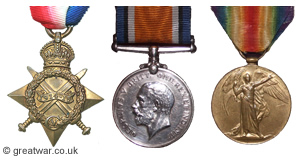
|
Pip, Squeak and Wilfred are the affectionate names given to the three WW1 campaign medals — The 1914 Star or 1914-15 Star, British War Medal and Victory Medal respectively. These medals were primarily awarded to the Old Contemptibles (B.E.F.). and by convention all three medals are worn together and in the same order from left to right when viewed from the front. The set of three medals or at least the British War Medal and the Victory Medal are the most likely medals to be found among family heirlooms.
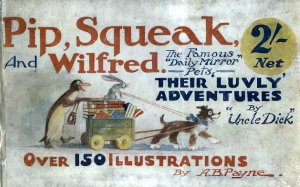
When the WW1 medals were issued in the 1920's it coincided with a popular comic strip published by the Daily Mirror newspaper. It was written by Bertram J. Lamb (Uncle Dick), and drawn by the cartoonist Austin Bowen Payne (A.B. Payne). Pip was the dog, Squeak the penguin and Wilfred the young rabbit. It is believed that A. B. Payne's batman during the war had been nicknamed “Pip-squeak” and this is where the idea for the names of the dog and penguin came from. For some reason the three names of the characters became associated with the three campaign medals being issued at that time to many thousands of returning servicemen, and they stuck.
“Mutt and Jeff”
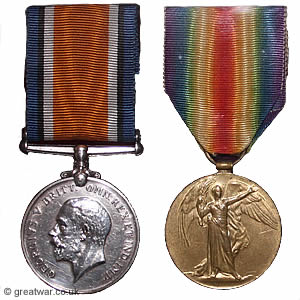
|
In a similar vein when only the British War Medal and Victory Medal are on display together they are sometimes known as “Mutt and Jeff”.
The 1914 Star
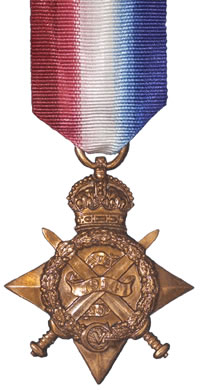
Established in April 1917.
Also known as 'Pip' or the 'Mons Star'.
This bronze medal award was authorized by King George V in April 1917 for those who had served in France or Belgium between 5th August 1914 to midnight on 22nd November 1914 inclusive. The award was open to officers and men of the British and Indian Expeditionary Forces, doctors and nurses as well as Royal Navy, Royal Marines, Royal Navy Reserve and Royal Naval Volunteer Reserve who served ashore with the Royal Naval Division in France or Belgium.
A narrow horizontal bronze clasp sewn onto the ribbon, bearing the dates '5th AUG. - 22nd NOV. 1914' shows that the recipient had actually served under fire of the enemy during that period. For every seven medals issued without a clasp there were approximately five issued with the clasp.

Recipients who received the medal with the clasp were also entitled to attach a small silver heraldic rose to the ribbon when just the ribbon was being worn.
The reverse is plain with the recipient's service number, rank, name and unit impressed on it.
It should be remembered that recipients of this medal were responsible for assisting the French to hold back the German army while new recruits could be trained and equipped. Collectively, they fully deserve a great deal of honour for their part in the first sixteen weeks of the Great War. This included the battle of Mons, the retreat to the Seine, the battles of Le Cateau, the Marne, the Aisne and the first battle of Ypres. There were approximately 378,000 1914 Stars issued.
The 1914-15 Star
Established in December 1918.
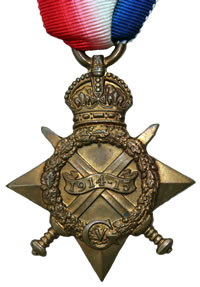
Also known as 'Pip'.
This bronze medal was authorized in 1918. It is very similar to the 1914 Star but it was issued to a much wider range of recipients. Broadly speaking it was awarded to all who served in any theatre of war against Germany between 5th August 1914 and 31st December 1915, except those eligible for the 1914 Star. Similarly, those who received the Africa General Service Medal or the Sudan 1910 Medal were not eligible for the award.
Like the 1914 Star, the 1914-15 Star was not awarded alone. The recipient had to have received the British War Medal and the Victory Medal. The reverse is plain with the recipient's service number, rank, name and unit impressed on it.
An estimated 2.4 million of these medals were issued.
The British War Medal, 1914-18
Established on 26th July 1919.
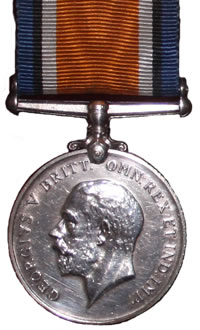
Also known as 'Squeak'.
The silver or bronze medal was awarded to officers and men of the British and Imperial Forces who either entered a theatre of war or entered service overseas between 5th August 1914 and 11th November 1918 inclusive. This was later extended to services in Russia, Siberia and some other areas in 1919 and 1920.
Approximately 6.5 million British War Medals were issued. Approximately 6.4 million of these were the silver versions of this medal. Around 110,000 of a bronze version were issued mainly to Chinese, Maltese and Indian Labour Corps. The front (obv or obverse) of the medal depicts the head of George V.
The recipient's service number, rank, name and unit was impressed on the rim.
The Allied Victory Medal
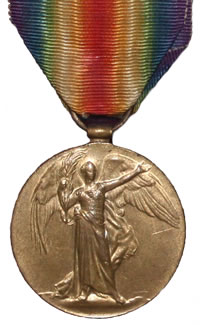
Also known as 'Wilfred'
It was decided that each of the allies should each issue their own bronze victory medal with a similar design, similar equivalent wording and identical ribbon.
The British medal was designed by W. McMillan. The front depicts a winged classical figure representing victory.
Approximately 5.7 million victory medals were issued. Interestingly, eligibility for this medal was more restrictive and not everyone who received the British War Medal ('Squeak') also received the Victory Medal ('Wilfred'). However, in general, all recipients of 'Wilfred' also received 'Squeak' and all recipients of 'Pip' also received both 'Squeak' and 'Wilfred'.
The recipient's service number, rank, name and unit was impressed on the rim.
The Territorial Force War Medal, 1914-1919
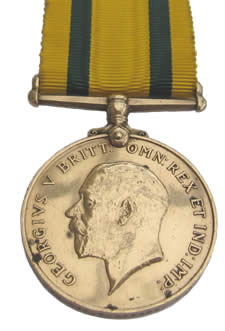
Instituted on 26th April 1920.
Only members of the Territorial Force and Territorial Force Nursing Service were only eligible for this medal. They had to have been a member of the Territorial Force on or before 30th September 1914 and to have served in an operational theatre of war outside the United Kingdom between 5th August 1914 and 11th November 1918. An individual who was eligible to receive the 1914 Star or 1914/15 Star could not receive the Territorial War Medal.
The obverse (front) of the medal shows an effigy of King George V with the words GEORGIVS BRITT OMN:REX ET IND: IMP:
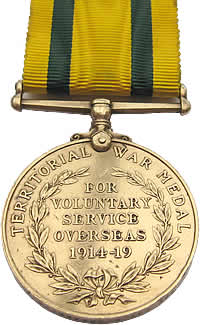
The reverse of the medal has the words TERRITORIAL WAR MEDAL around the rim, with a laurel wreath and the words inside the wreath FOR VOLUNTARY SERVICE OVERSEAS 1914-1919.
Approximately 34,000 Territorial Force War Medals were issued.
The Silver War Badge
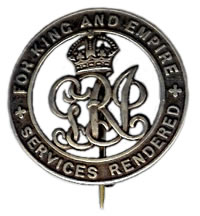
The Silver War Badge was issued on 12th September 1916.
The badge was originally issued to officers and men who were discharged or retired from the military forces as a result of sickness or injury caused by their war service. After April 1918 the eligibility was amended to include civilians serving with the Royal Army Medical Corps, female nurses, staff and aid workers.
Around the rim of the badge was inscribed “For King and Empire; Services Rendered”. It became known for this reason also as the “Services Rendered Badge”. Each badge was also engraved with a unique number on the reverse, although this number is not related to the recipient's Service Number.
The recipient would also receive a certificate with the badge. The badge was made of Sterling silver and was intended to be worn on the right breast of a recipient's civilian clothing. It could not be worn on a military uniform.
There were about 1,150,000 Silver War Badges issued in total for First World War service.
Mercantile Marine War Medal
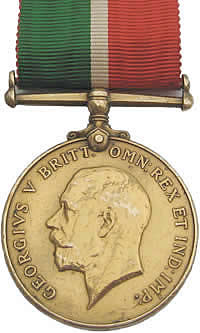
The medal was established in 1919.
The Board of Trade awarded this campaign medal, the Mercantile Marine War Medal, to people who had served in the Merchant Navy and who had made a voyage through a war zone or danger zone during the 1914-1918 war.
It was a circular bronze medal. It was 1.42 inches in diameter. On the obverse (front) there was an effigy of King George V facing to the left with the words GEORGIVS V BRITT: OMN: REX ET IND: IMP:.
The reverse of the medal has a laurel wreath around the rim with an image of a merchant ship on a stormy sea with an enemy submarine and an old sailing ship to the right of the merchant ship. The inscription on this side of the medal is FOR WAR SERVICE/MERCANTILE MARINE 1914-1918.
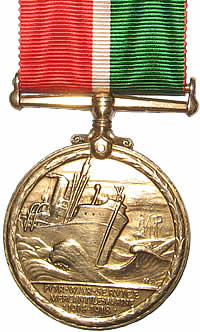
The ribbon (1.25 inches wide) is green on the left and red on the right with a thin white line in the centre between the two. The green and red colours of the ribbon represent the starboard and port running lights of a ship with the centre white colour being representative of the masthead steaming light.
133,135 Mercantile Marine War Medals were awarded.
Related Topics
Researching Medal Awards
Every individual who served in a theatre of war on active service between 1914 and 1920 was eligible for the award of a campaign medal. For information about the medal records and where you can view them go to our page at:
British Army WW1 Medal Records 1914-1920
British Awards for Gallantry
For information about British Gallantry Awards go to our page at:
British Gallantry AwardsReplica Medals & Medal Ribbons
Replacement replica medals, medal ribbons and a replica of the Next of Kin Memorial Plaque can be obtained. A highly recommended specialist military medals company is C & J Medals, based in Reading, Berkshire:
Website: www.cjmedals.co.uk
Further Reading

Medals: The Researcher's Guide
by William Spencer
The British government has bestowed a wide range of awards. This awards system is a great opportunity for historical research, whether your starting point is an ancestor, a regiment, a campaign, or a medal. Unlike other works which focus on medals identification, this guide shows you how to fully exploit the associated records. Enriched with case studies and full-colour photography, it is your ideal companion to medals research.

British Campaign Medals of the First World War (Shire Library) (paperback)
by Peter Duckers
Handy paperback guide in 56 pages including information about the Theatres of War, other Allied medals and how to research medals.

British Gallantry Awards
by Peter Duckers
Since ancient times soldiers have been honoured for gallantry in battle. Over the years and in different societies such honours have taken many forms but since the 1850s specific acts of bravery 'in the face of the enemy' by British and Imperial forces have been recognised by the award of a range of wearable decorations. These provide a visible indication both of the bravery of the recipient and of its recognition by the government and nation.
Acknowledgements
Images of the Territorial Force War Medal and Mercantile Marine War Medal courtesy of Vic Freeman
Image of Silver War Badge courtesy of Martin Fore

